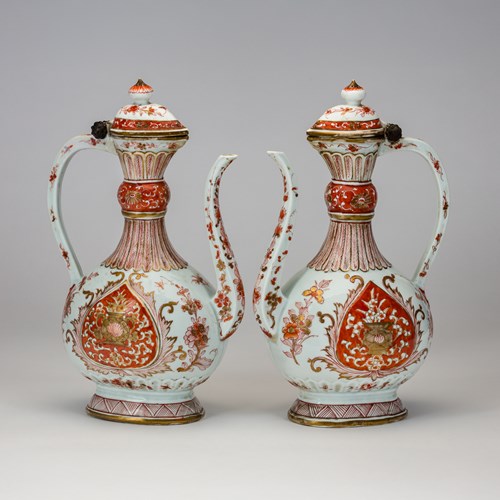Marketplace
Iznik pottery jug
Iznik pottery jug
Date c. 1600
Epoque Early 17th century
Origine Ottoman Turkey
Medium Ceramic decorated with underglaze polychrome
Dimension 25 x 14 cm (9⁷/₈ x 5¹/₂ inches)
A pear-shaped polychrome Iznik jug with a broad bulbous body, joined by a narrow nearly cylindrical neck gently fluting outward, standing on a splayed foot-ring. The neck is attached with a curved handle with a knop at the juncture with the body. The jug is painted in cobalt-blue, runny green and bole red outlined in greenish black with rosettes, curved sprays of carnations and dotted tulips interspersed with medallions featuring flower buds. The rim of the neck and the base of the foot feature bands of marbling design.
Jugs of this kind were a regular part of the production of the Iznik potters. They were probably mostly used for serving drink, though similar jugs in contemporary miniatures hold flowers like those painted on the jug itself. The second half of the 16th century witnessed an increasing diversity in Iznik ceramic forms, as well as high achievement. Jugs such as this were painted with a rich repertoire of motifs on crisp white ground, clear transparent glaze and vivid colours, creating a harmonious decorative scheme. The court design studio, headed by Kara Memi, provided a repertoire of naturalistic motifs, including tulips, roses, hyacinths, narcissi and other flowers, cypress and pomegranate trees, and branches of prunus blossom. They became the principal motifs of Ottoman art.
This jug has similarities to jugs at the British Museum (1878,1230.473) and the Victoria and Albert Museum (204-1887, 728-1893, 330-1897, C.266-1921)
Stock no.: A5401
Jugs of this kind were a regular part of the production of the Iznik potters. They were probably mostly used for serving drink, though similar jugs in contemporary miniatures hold flowers like those painted on the jug itself. The second half of the 16th century witnessed an increasing diversity in Iznik ceramic forms, as well as high achievement. Jugs such as this were painted with a rich repertoire of motifs on crisp white ground, clear transparent glaze and vivid colours, creating a harmonious decorative scheme. The court design studio, headed by Kara Memi, provided a repertoire of naturalistic motifs, including tulips, roses, hyacinths, narcissi and other flowers, cypress and pomegranate trees, and branches of prunus blossom. They became the principal motifs of Ottoman art.
This jug has similarities to jugs at the British Museum (1878,1230.473) and the Victoria and Albert Museum (204-1887, 728-1893, 330-1897, C.266-1921)
Stock no.: A5401
Date: c. 1600
Epoque: Early 17th century
Origine: Ottoman Turkey
Medium: Ceramic decorated with underglaze polychrome
Dimension: 25 x 14 cm (9⁷/₈ x 5¹/₂ inches)
Plus d'œuvres d'art de la Galerie









_T638617373368030677.jpg?width=500&height=500&mode=pad&scale=both&qlt=90&format=jpg)